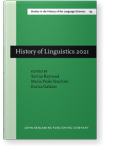Chapter 17
The structuralist quest for general meanings
Mapping the history of monosemy in grammatical semantics
This article reconstruct the history and development of the methodology known as “of general
meanings”, widely adopted in 20th century structural linguistics and grammatical semantics starting from the Thirties
onwards, tracking its roots in the framework of German Allgemeine Sprachlehre and discussing the
debate that it engendered within the structural paradigm, where the notions of “general” vs. “fundamental meanings”
(Gesamt- vs. Grundbedeutung) were defined and gained currency, often marking the
competing approaches of Prague vs. Copenhagen schools. In so doing, the paper offers a detailed insight on the
philosophical background of such a methodology, reconstructing its epistemological framework and its legacy,
contributing in mapping the evolution of one of its most important corollary: monosemy.
Article outline
- 1.Introduction
- 2.Kant, German romantic philology and the motivation of grammatical forms
- 3.The structuralist turn
- 4.Extending the count
- 5.Perspectives and conclusions
- Author queries
-
Notes
-
References
This content is being prepared for publication; it may be subject to changes.
